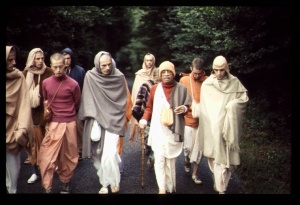CC Madhya 25.267 (1975): Difference between revisions
(Vanibot #0027: CCMirror - Mirror CC's 1996 edition to form a basis for 1975) |
(Vanibot #0020: VersionCompareLinker - added a link to the Version Compare feature) |
||
| Line 2: | Line 2: | ||
<div style="float:left">'''[[Sri Caitanya-caritamrta (1975)|Śrī Caitanya-caritāmṛta (1975)]] - [[CC Madhya (1975)|Madhya-līlā]] - [[CC Madhya 25 (1975)|Chapter 25: How All the Residents of Vārāṇasī Became Vaiṣṇavas]]'''</div> | <div style="float:left">'''[[Sri Caitanya-caritamrta (1975)|Śrī Caitanya-caritāmṛta (1975)]] - [[CC Madhya (1975)|Madhya-līlā]] - [[CC Madhya 25 (1975)|Chapter 25: How All the Residents of Vārāṇasī Became Vaiṣṇavas]]'''</div> | ||
<div style="float:right">[[File:Go-previous.png|link=CC Madhya 25.266 (1975)|Madhya-līlā 25.266]] '''[[CC Madhya 25.266 (1975)|Madhya-līlā 25.266]] - [[CC Madhya 25.268 (1975)|Madhya-līlā 25.268]]''' [[File:Go-next.png|link=CC Madhya 25.268 (1975)|Madhya-līlā 25.268]]</div> | <div style="float:right">[[File:Go-previous.png|link=CC Madhya 25.266 (1975)|Madhya-līlā 25.266]] '''[[CC Madhya 25.266 (1975)|Madhya-līlā 25.266]] - [[CC Madhya 25.268 (1975)|Madhya-līlā 25.268]]''' [[File:Go-next.png|link=CC Madhya 25.268 (1975)|Madhya-līlā 25.268]]</div> | ||
{{CompareVersions|CC|Madhya 25.267|CC 1975|CC 1996}} | |||
{{RandomImage}} | {{RandomImage}} | ||
==== TEXT 267 ==== | ==== TEXT 267 ==== | ||
<div class="verse"> | <div class="verse"> | ||
:bhakta | :bhakta lāgi' vistārilā āpana-vadane | ||
:kāhāṅ bhakta-mukhe kahāi śunilā āpane | :kāhāṅ bhakta-mukhe kahāi śunilā āpane | ||
</div> | </div> | ||
| Line 18: | Line 17: | ||
<div class="synonyms"> | <div class="synonyms"> | ||
bhakta | bhakta lāgi'—especially for the purpose of His devotees; vistārilā—expansively described; āpana-vadane—personally, with His own mouth; kāhāṅ—sometimes; bhakta-mukhe—through the mouth of His devotees; kahāi—making describe; śunilā āpane—listened Himself. | ||
</div> | </div> | ||
| Line 25: | Line 24: | ||
<div class="translation"> | <div class="translation"> | ||
Śrī Caitanya Mahāprabhu broadcast the | Śrī Caitanya Mahāprabhu broadcast the purpose of Śrīmad-Bhāgavatam. He sometimes spoke for the benefit of His devotees and sometimes empowered one of His devotees to speak while He listened. | ||
</div> | </div> | ||
| Line 32: | Line 31: | ||
<div class="purport"> | <div class="purport"> | ||
Śrī Caitanya Mahāprabhu, as an ideal teacher, or ācārya, explained Śrīmad-Bhāgavatam very elaborately Himself. He sometimes also empowered His devotees to speak while He listened. This is the way an ācārya should train | Śrī Caitanya Mahāprabhu, as an ideal teacher, or ācārya, explained Śrīmad-Bhāgavatam very elaborately Himself. He sometimes also empowered His devotees to speak while He listened. This is the way an ācārya should train His disciples. Not only should he describe the bhāgavata cult personally, but he should also train his disciples to speak on this sublime subject. | ||
</div> | </div> | ||
Latest revision as of 16:31, 27 January 2020

A.C. Bhaktivedanta Swami Prabhupada
TEXT 267
- bhakta lāgi' vistārilā āpana-vadane
- kāhāṅ bhakta-mukhe kahāi śunilā āpane
SYNONYMS
bhakta lāgi'—especially for the purpose of His devotees; vistārilā—expansively described; āpana-vadane—personally, with His own mouth; kāhāṅ—sometimes; bhakta-mukhe—through the mouth of His devotees; kahāi—making describe; śunilā āpane—listened Himself.
TRANSLATION
Śrī Caitanya Mahāprabhu broadcast the purpose of Śrīmad-Bhāgavatam. He sometimes spoke for the benefit of His devotees and sometimes empowered one of His devotees to speak while He listened.
PURPORT
Śrī Caitanya Mahāprabhu, as an ideal teacher, or ācārya, explained Śrīmad-Bhāgavatam very elaborately Himself. He sometimes also empowered His devotees to speak while He listened. This is the way an ācārya should train His disciples. Not only should he describe the bhāgavata cult personally, but he should also train his disciples to speak on this sublime subject.